Some types of play help kids understand more about how things work and about responsibility!
And play can make these learning experiences so much fun. This guide explains why play is important, the types and stages, then lists great resources, people and products to help you on your journey towards more capable children. Let's dive in...
The Role of Practical Play:
Why we play:
Play is children’s work. While play is often seen as something children do for leisure, play is actually a important part of a child’s development. Play is a self-chosen and self-directed activity that is focused on the process of play and not the product of it. As in, play is individually constructed to meet the child’s own desires and needs.
Play is imaginative and active. Through play, children develop cognitive skills and learn new information. They learn and practice social skills, like effective communication, self-regulation, conflict resolution, problem-solving, and cooperation. Equally as important is how they learn about themselves by exploring roles, interests, skills, and relationships. Play is how children explore their world.
Types of play:
According to Piaget, children engage in types of play that reflect their level of cognitive development. Each type of play emerges at different ages and stages of cognitive development, and the depth of the level of play changes with maturation, as well (Johnson, Christie & Wardle 2005).
- Functional play involves repetitive, physical actions, language, and manipulation of objects. Beginning in infancy, children learn that they have control of their bodies and objects, and they can act upon those objects. Infants play through repetitive actions, like shaking a rattle, splashing in the bath, or repeatedly dropping toys from their high chair. These basic actions become play when the child deliberately engages in the activity for pleasure (Frost, 1992). Eventually, as children become more cognitively sophisticated, simple, repetitive actions are replaced by more complex, coordinated actions. Functional play is enjoyed by children throughout their childhood, particularly as they discover and practice new motor skills, such as sliding, climbing, stacking, jumping, and bouncing.
- Constructive play begins at the age of two, when children progress from simple, repetitive functional play to goal-directed, creative activities. When children manipulate objects to create something, they are engaging in constructive play. They use objects like blocks, clay, and craft supplies in an organized way to achieve a goal. Constructive play is a form of hand-on inquiry where children gain knowledge by posing questions, testing ideas, and gathering information (Drew et al., 2008) through experimentation with basic materials to create something more complex. This type of play encourages planning, exploration, and discovery (Child Development Institute, 2010).
- Symbolic play is the ability of children to use objects, actions, or ideas to represent other objects, actions, or ideas in play. These activities may include role-playing or make-believe play, such as pretending to be a baby, firefighter, or monster, and make-believe actions, such as driving a car by moving a pretend steering wheel, or using a banana as a telephone. This level of play is widely considered the most sophisticated play activity during the preschool and kindergarten years. Symbolic play encourages the development of social skills, academic abilities, early literacy concepts, and behavioral self-regulation (Leong & Bodrova 2015).
- Games with Rules includes play activity with imposed rules that must be followed by the players. To successfully participate at this level of play, children must have the cognitive ability to understand and remember the rules. These games also require the children to self-regulate, curb their own desires and needs to adhere to the rules of the game. Games with rules are often characterized by logic and order, and they help children develop an understanding of cooperation and competition. By initiating their own games with rules, children learn the need for rules, how to negotiate with each other, and fairness so that the game is enjoyable for everyone.
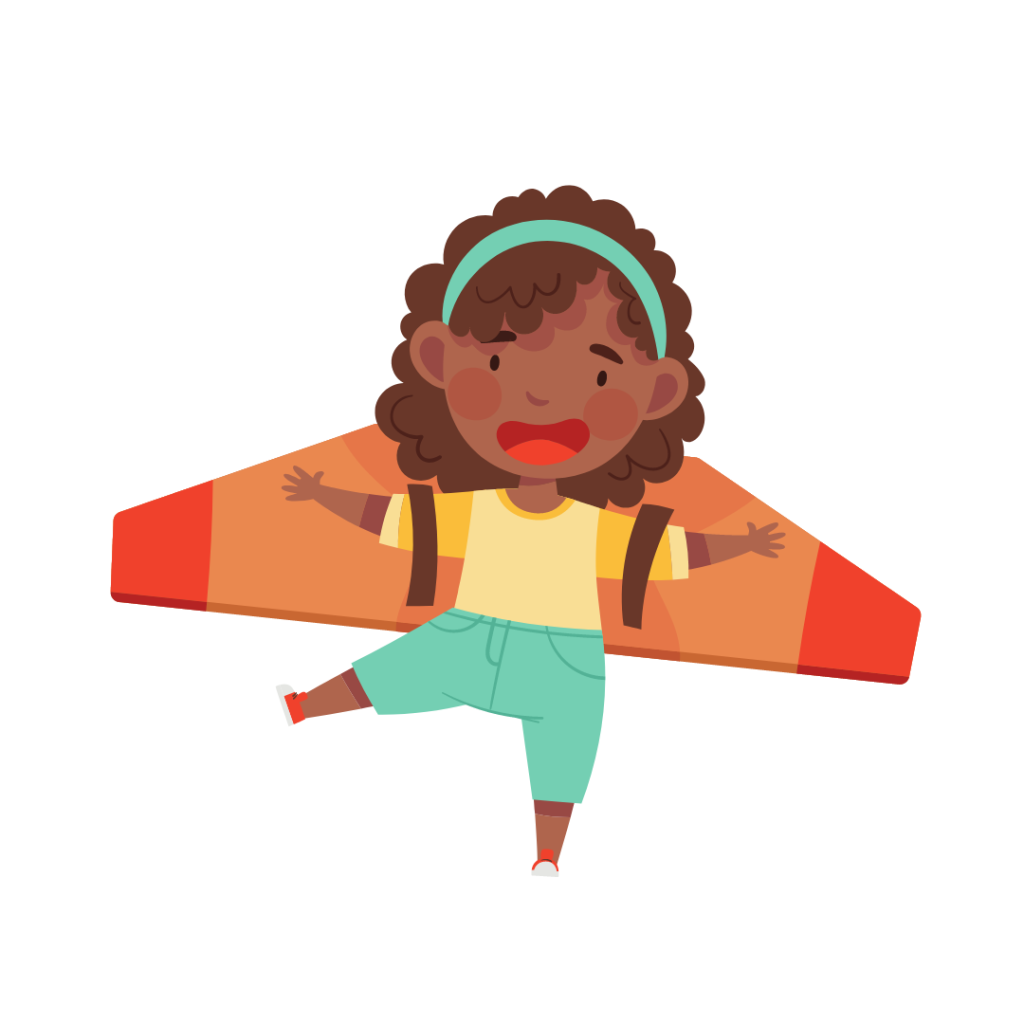
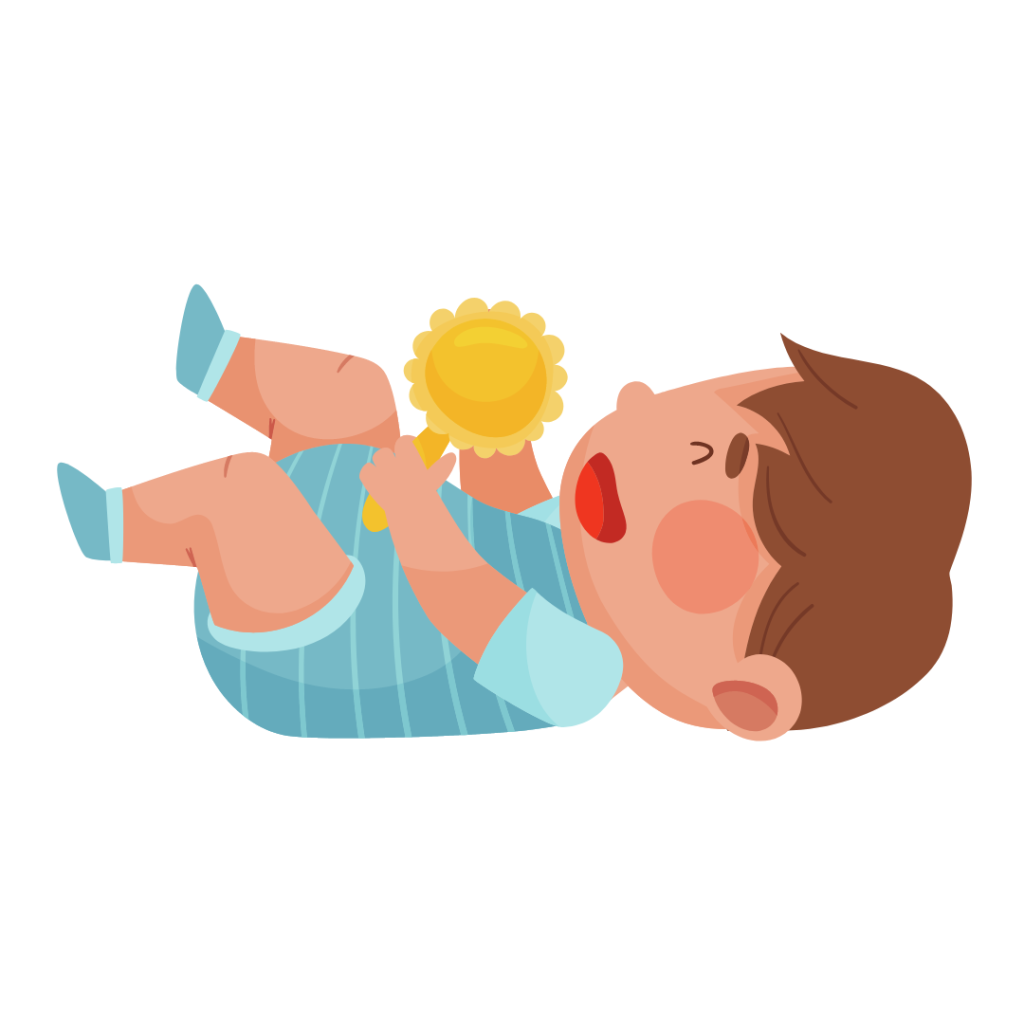



Why Practical Play Matters:


Professor Sara Smilansky found that children that did not engage in this level of play displayed cognitive and emotional delays. This effect was especially present in underprivileged children. In response, Smilansky proposed that to facilitate children’s development of pretend play, adults should encourage:
- Imitative role play. The child pretends to play a role and expresses it in an imitates that role. For example, “I am the teacher, and you are my students.”
- Make-believe with objects. Use nonrealistic objects to represent real objects and actions. For example, pretending a stick is a horse and riding it.
- Verbal make-believe. Incorporate verbal dialog and descriptions in place of actions. For example, “Let’s pretend I cooked the dinner, and now I am setting the table” when only the last activity is actually imitated.
- Persistence in role play. The pretend play episode lasts for at least 10 minutes.
- Interaction. Two or more players interact within the context of a play episode.
- Verbal communication. There is some verbal interaction with other players related to the play episode.
Stages of Play (milestones):
Researcher Mildred Parten identified 6 different types of play in children. Three types were labeled as non-social play (unoccupied, solitary, and onlooker), and three types were categorized as social play (parallel, associative, and cooperative).
Parten also found that once a child has developed the ability to participate in a particular stage of social play, they will use combinations of that stage and earlier stages while playing. However, we find that younger children engage in non-social play more than those older and, by age five, associative and cooperative play are the most common forms of play (Dyer & Moneta, 2006).

Unoccupied
The earliest and least common style of play throughout childhood is the unoccupied stage. This is a non-social stage that starts in infancy and may appear as random behavior without a specific goal. During this time, the child is not playing. Sitting or standing still, random movements or movements without purpose that do not meet the above definition of play can all be considered unoccupied time. Infants and toddlers may spend significant parts of their day disengaged from any play, but the amount of time spent unoccupied should decrease as children age.
Solitary Play
Another non-social stage is solitary play. Common in children 2-3 years of age, this style of play involves a child playing alone and maintaining focus on their activity. They do not interact with others, nor are they interested in what others are doing. They also are not engaging in similar activities as the children around them. No matter the play activity, whether functional, constructive, symbolic, or game play, if the child is playing alone then it is solitary play.
Onlooker Play
Onlooker play is the final type of non-social play. During this style of play, children are observing others playing. The child may socialize with the other children, such as commenting on the activities and even make suggestions, but they will not directly join the play. Onlooker play is different from unoccupied play because, while the child is not participating in the play activity, they are engaged in social interaction and active observation.
Parallel Play
Sometimes seen as a transitory stage from immature non-social types to the more socially mature types of play, parallel play is when a child plays adjacent to, but not with, others. The child plays separately from others, engaged in their own play with their own goals; however, the children are close enough to observe and mimicking other’s behaviors.
Associative Play
Around the age of 3, children will interact with each other and share toys; however, they are not yet working toward a common play goal. This more sophisticated social contact is associative play. The children will engage in the same play activity and show interest in what others are doing, but not in coordinating their activities with those people.
Cooperative Play
The child is interested both in the people playing and in coordinating their activities. In cooperative play, the activity is organized, participants have assigned roles, and children may take on different tasks to reach their shared goal. There is also increased self-identification with a group, and a group identity may emerge.
Educational Articles:
- Child’s Passport to Cognitive Growth: 15 Ways Play Fosters Development
- The Five Stages of Pretend Play and the Influence of Digital Technology
- Why Pretend Play Rocks: A Fun Look at 5 Big Benefits for Your Kid
- The Power of Imaginative Play: Promoting Children’s Cognitive and Emotional Development
- The Power of Play: How Games and Educational Toys assist in Developmental Milestones
Professionals:
Dr. Jen Wolkin
Harvard-trained Neuropsych and author of of Quick Calm which is training support for mindfulness you can do in 5 mins per day.
Brittany S Hochstetler
Products for Practical Play

Mini Dyson
Designed to look, act and feel like the real Dyson parents use. Use it handheld to teach dusting or attach the long handle to teach floor vacuuming. Note: This uses light suction to pick up small pieces of paper and lightweight debris. For safety reasons it only contains light suction.

Cleaning Supplies
A durable set of cleaning supplies for your little helper. Teach a child that daily cleanliness matters with this mop, duster and broom set! The little handles make it easy for kids to help mirror parent’s cleaning habits. (Be sure to verify height so it fits your child well).

Wooden Tool Bench for Kids
This kids wooden workbench helps kids learn fine motor skills as well as hand-eye coordination by using the wrench, hammer and screw driver . Assembling nuts and bolts encourages logical thinking and problem solving, while projects encourage coordination, creativity, resilience.

Kids Car Wash Activity Kit
A real life set of car cleaning tools that are every bit as effective as their adult-sized companions. Help your kids understand that practical responsibilities can grow confidence, while being fun. This helps develop their motor skills and coordination but also gives them the confidence that they can complete physical tasks well.

Deluxe Kids Washer and Dryer Play set
A realistic wash room that lets kids pretend to clean clothes, fold linens, clean house, and organize their supplies just like a grown-up. This laundry room play set features realistic accessories; clicking knobs; turning dials; a beautiful arrangement of shelves, hooks, and closet space—even their own laundry basket!

Toddler Tool Set with Tool Box & Electronic Toy Drill
This 45 piece tool kit is just like Daddy’s including a handled tool kit, an electric drill (batteries not included), hammer, goggle, screwdrivers, protective mask and knife toy and a variety of wooden pieces, nails, nuts and more. Everything is fully functional and realistic so kids can practice engineering earlier than ever!
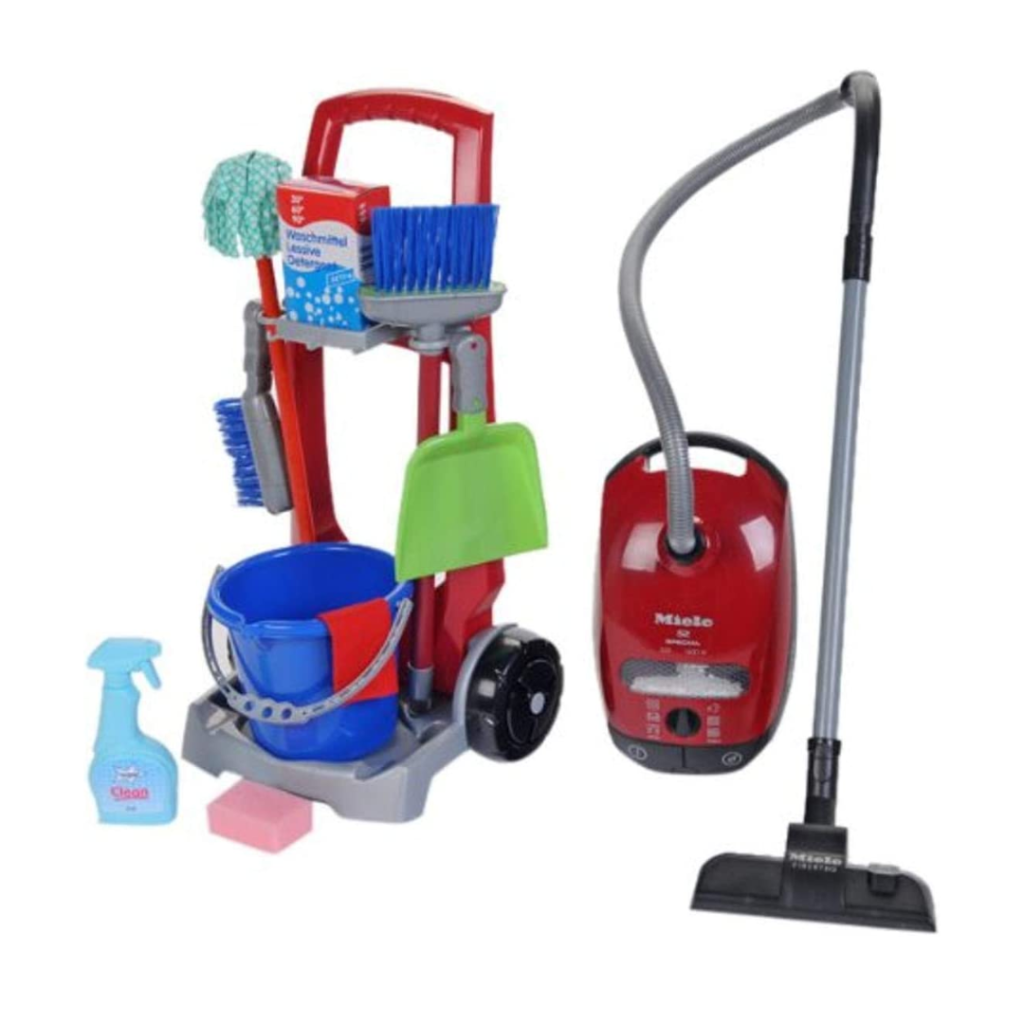
Cleaning Trolley with
Miele Vacuum Cleaner
Kids love to help mom clean up and they learn a lot while copying you keep tidy too! Get your kids ready for performing household chores while keeping them entertained with this adorable play set. The vacuum cleaner comes with lights and sounds so your child feels like their cleaning just like you.
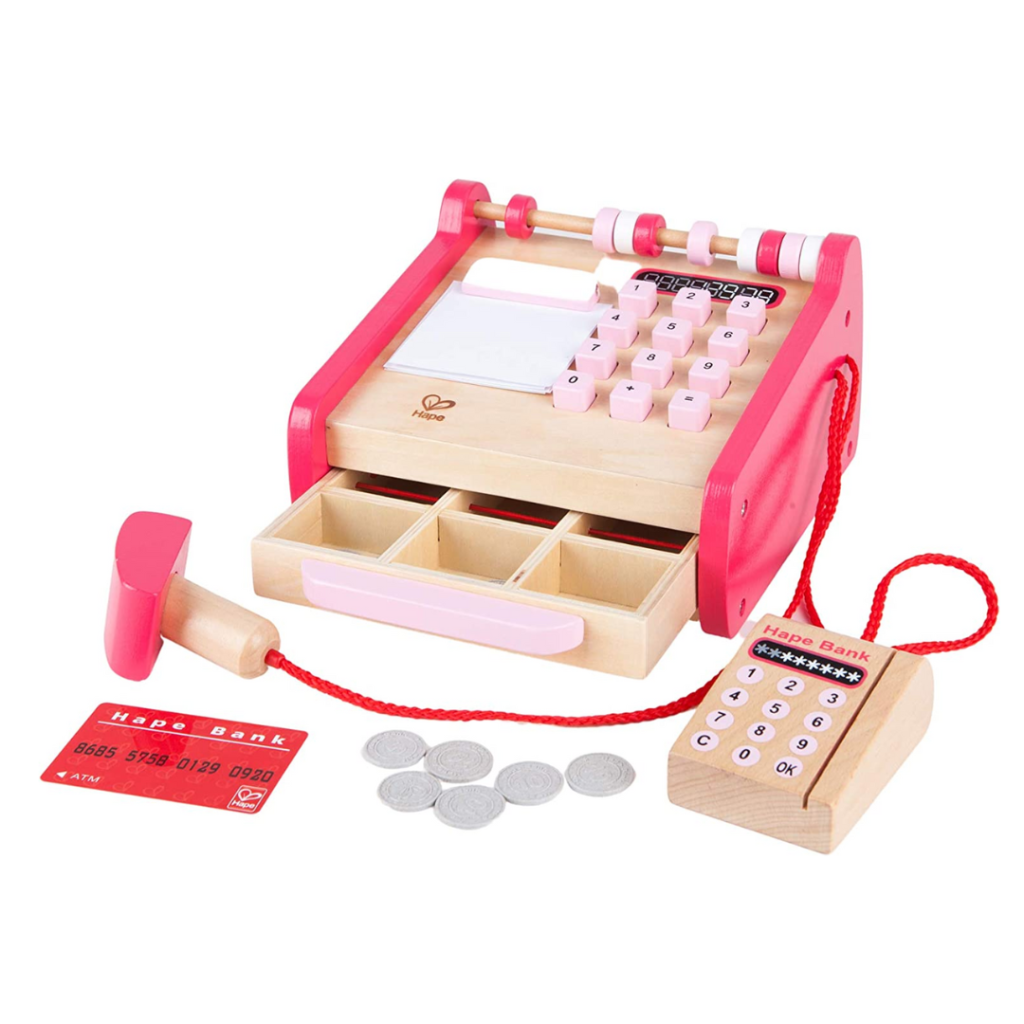
Wooden Register Pretend
& Play Role Play Set
This really high quality cashier play set is make of durable solid wood materials, and all finishes are non-toxic. It includes pushable buttons, coins, card processors, credit card and counting support for little ones. Teach kids basic math and money handling skills with this fun play set.
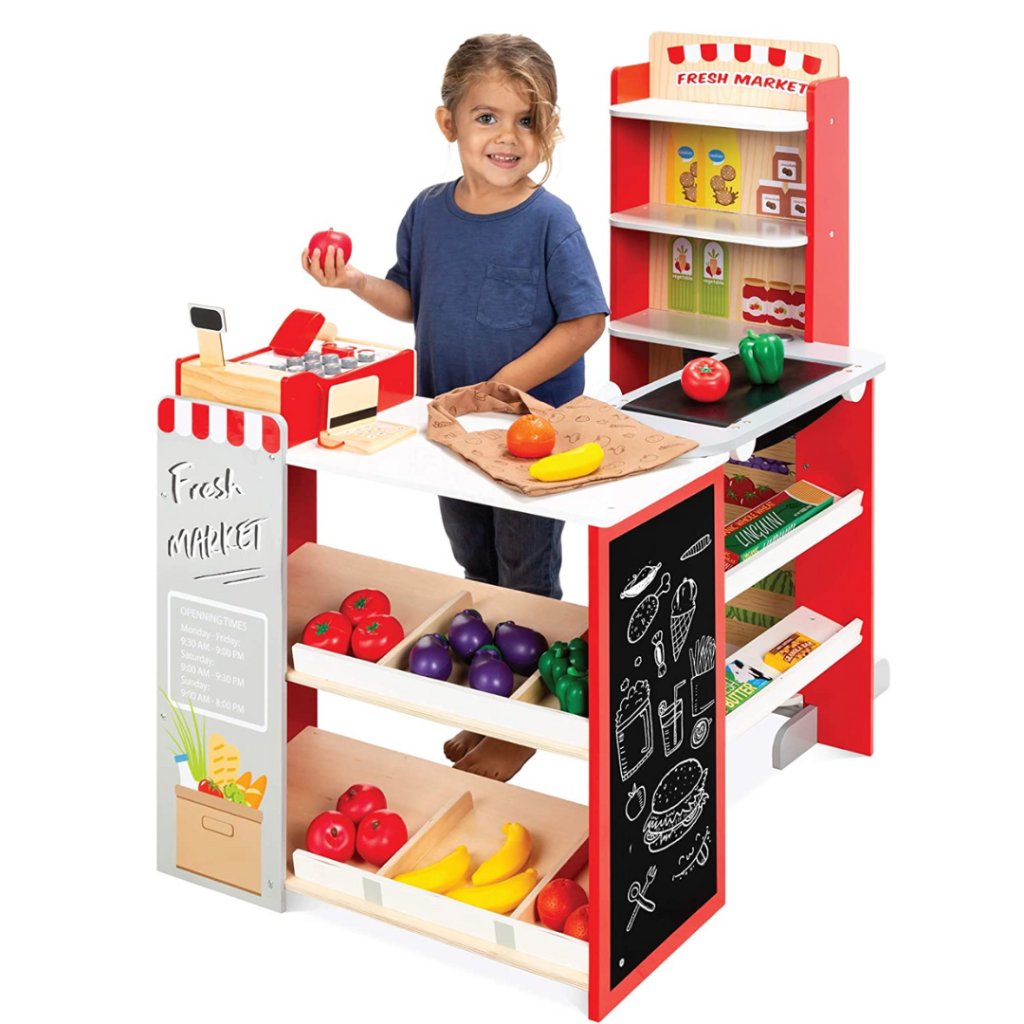
Grocery Store Wooden Supermarket Toy Set
Includes a checkout counter with a chalkboard to write special deals on, shelves for kids to store groceries, a working conveyor belt and a register that opens up so they can check out their items. It also has over 40 additional accessories like fruits, veggies, money, credit cards.
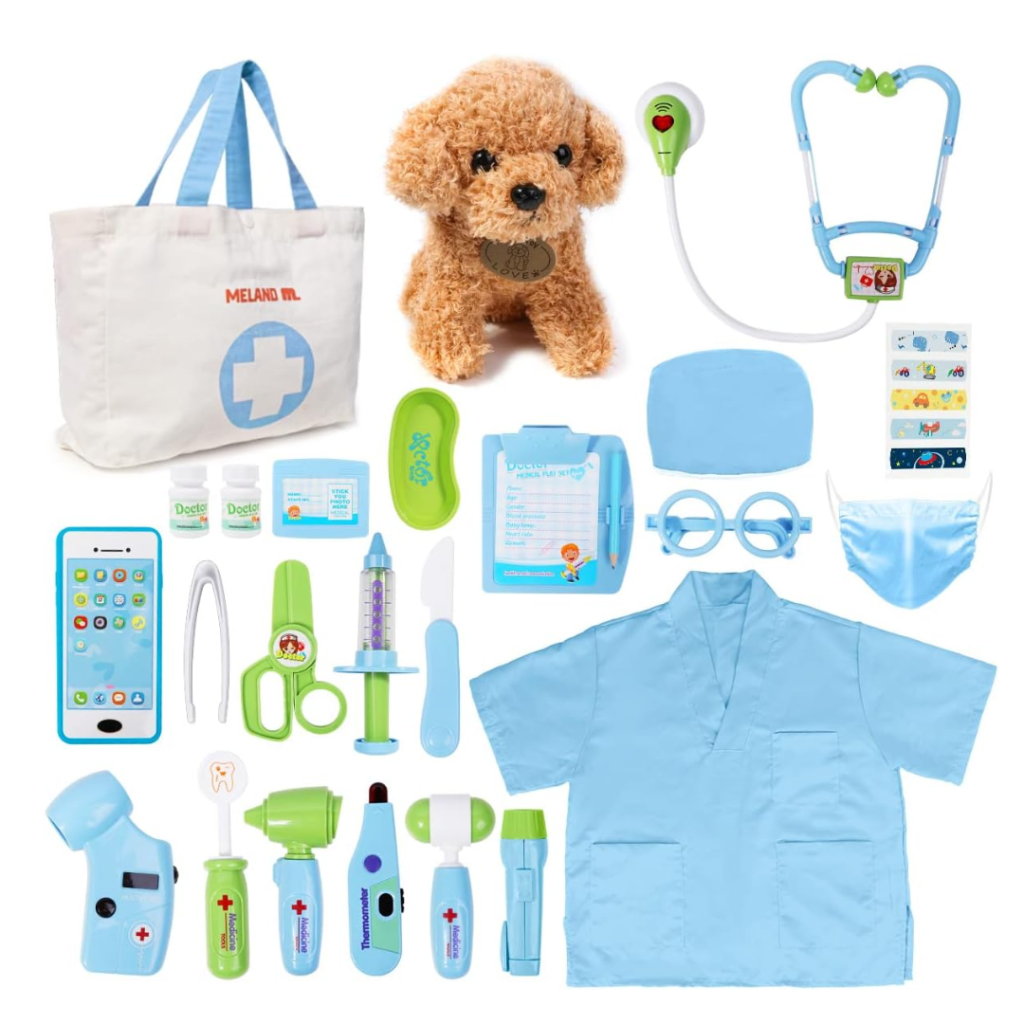
Pretend Play Doctor Set
Looking for a doctor’s playset that includes everyday items medical professionals use. This set features a Dog Toy, Carrying Bag, Electronic Stethoscope & Dress Up Costume, in addition to 17 other pieces to help a child check temperature, pulse, ears and more.
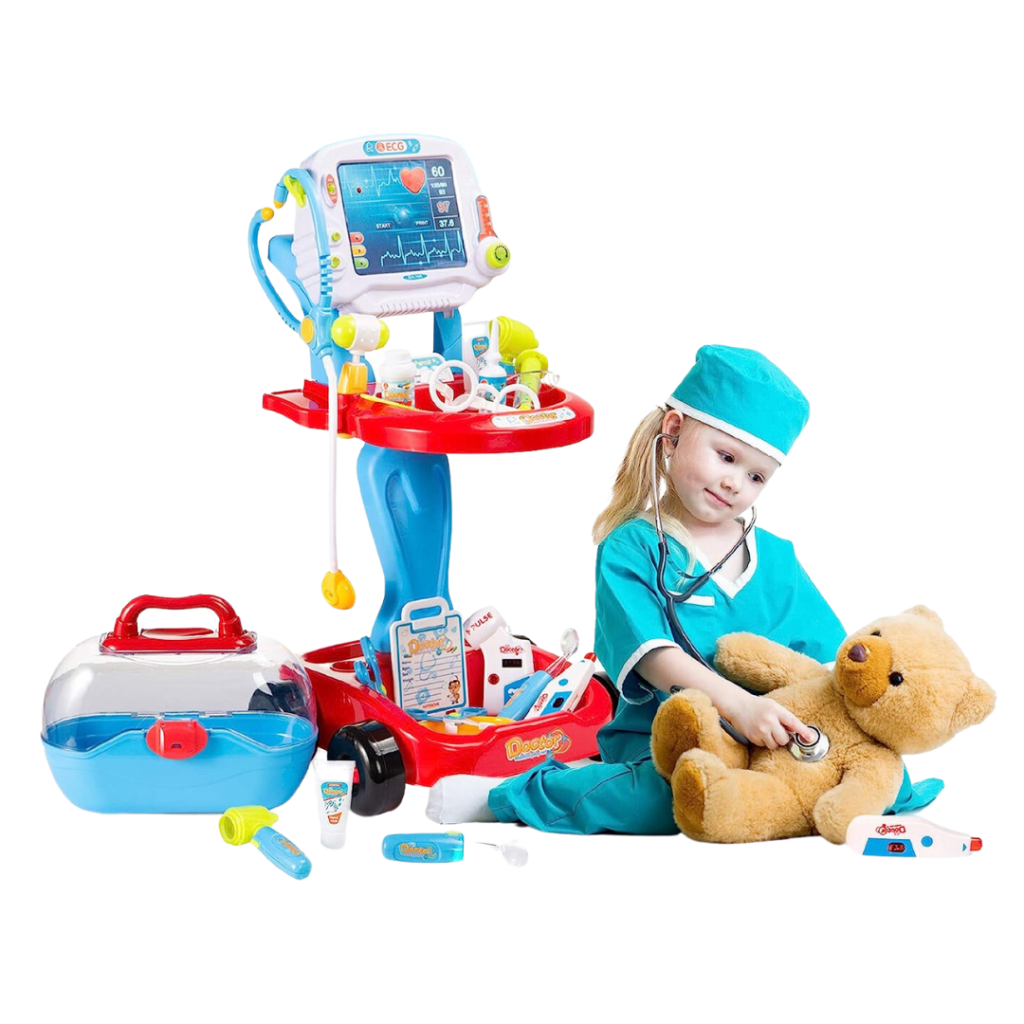
Pretend Medical Station Set
This upgraded medical set includes a LED enhanced EKG machine, pulse machine, thermometer, otoscope, and stethoscope! Family members and stuffed toys can receive regular check-ups with a cute mobile station designed with wheels, handles, and storage.
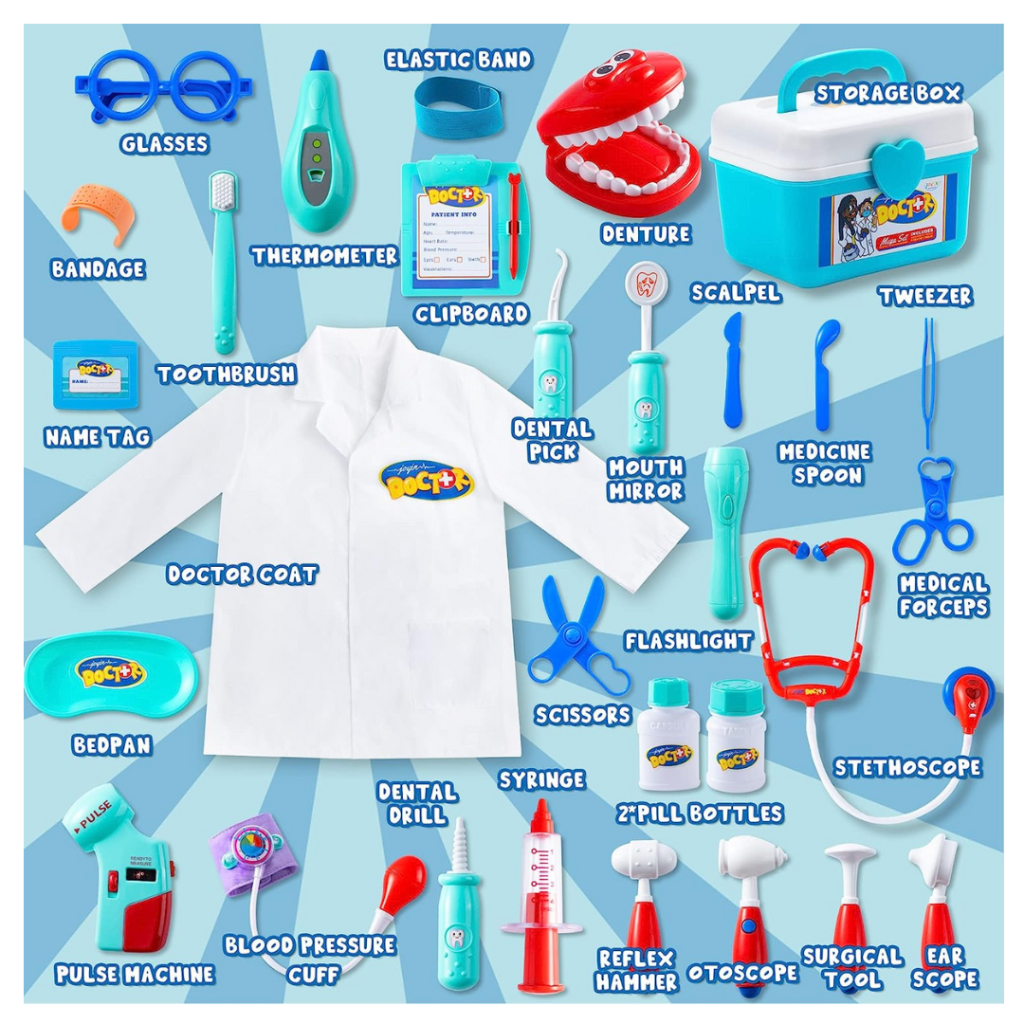
Dentist Medical Kit with Electronic Stethoscope
Need help getting your child used to the dentist? Help them prep for your next visit OR become a future dentist using this jam packed kids play set. Medical Kit Set Includes an electronic Stethoscope, a full costume and everything you need to review a patient’s pearly whites.
Books:
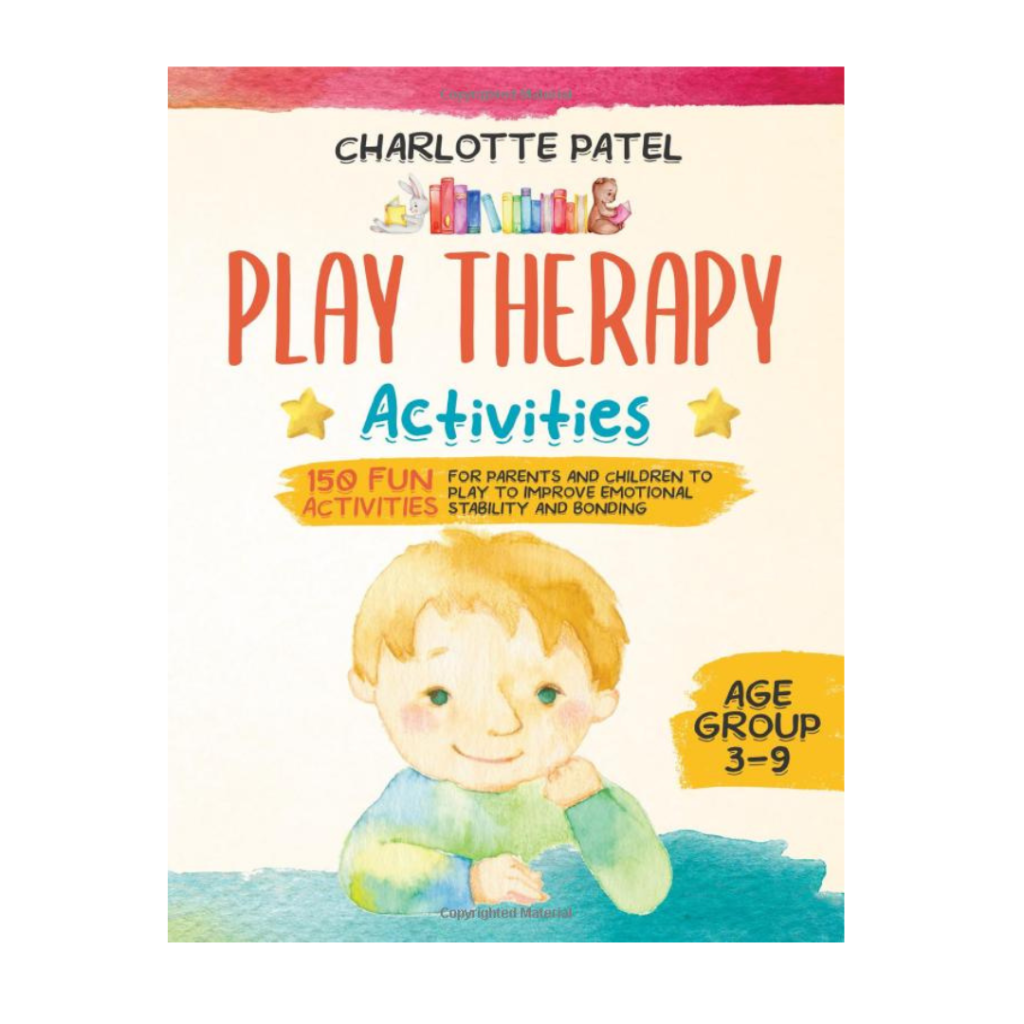
Play Therapy: 150 Fun Activities
Help kids grow the confidence they need to negotiate social situations at home, school, and throughout their lives. These exercises help kids build and employ their social skills; especially skills like keeping the discussion ball going, learning to compromise, practicing excellent table manners and more.
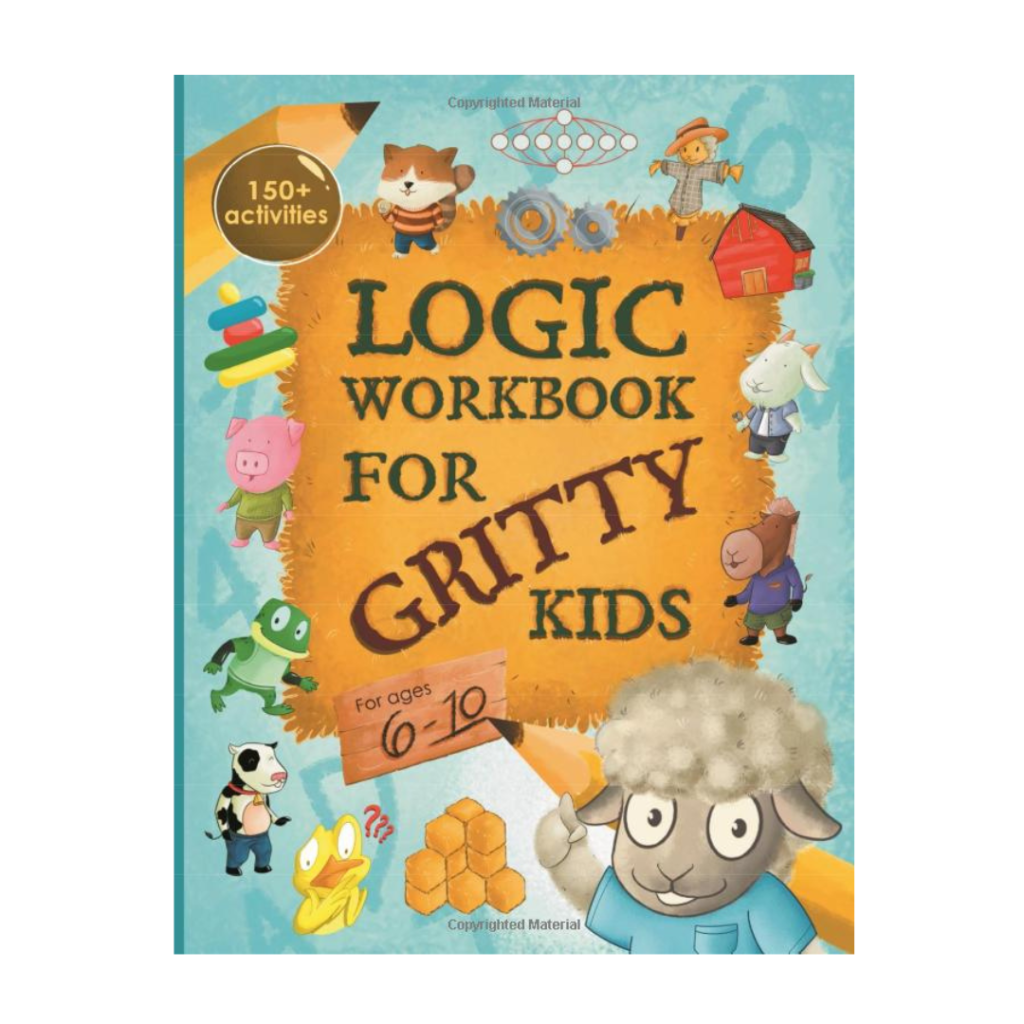
Spatial reasoning, math & logic puzzles, and more!
Kids learn about mental manipulation by visualizing the differences, movement and changes between shapes, spot patterns, and think about objects in three dimensions. They also play word games to improve problem-solving, memory, cognition, and creativity.
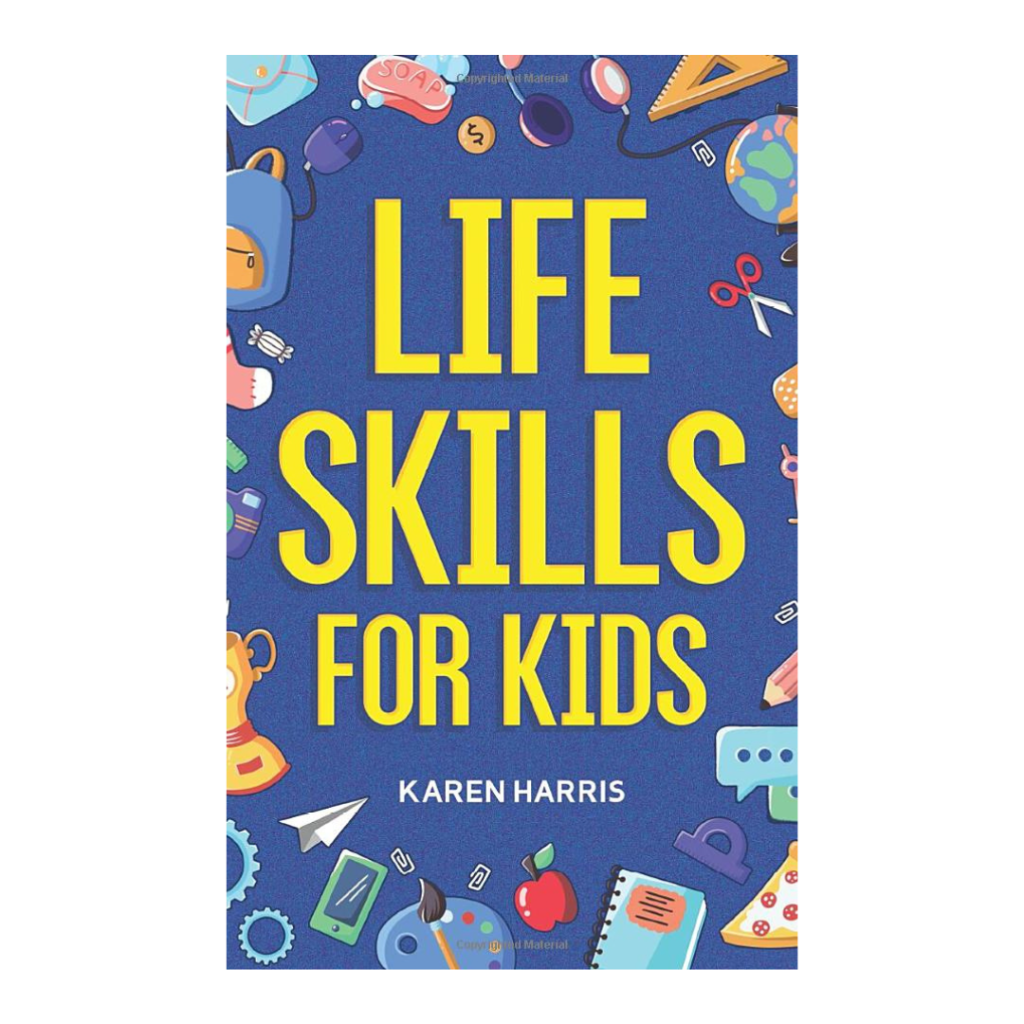
How to Cook, Clean, Handle Emergencies + more!
It’s more important than ever to make sure children learn basic life skills that are often neglected in our convenience driven era. Whether it is building autonomy in the kitchen or effectively navigating tough situations with bullies, Life Skills for Kids helps teach habits for a successful future.

